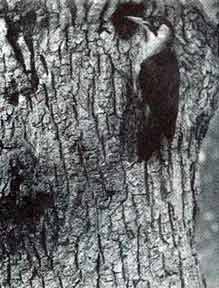Some Birds Of Britain, Page 3
By LEWIS WAYNE WALKER
A pair of green woodpeckers had bored a nesting chamber in the bole of a small ash tree that grew in a little hollow in a large meadow in Somersetshire. The boring was only about six feet from the ground, and telltale chips and wood dust were quite conspicuous at the foot of the tree. As there were cattle in the field, the blind could not be left in position for a very long time to allow the birds to become accustomed to its presence. It was therefore erected in the late evening, and by eleven o'clock the next morning the sun had moved around sufficiently to permit exposures to be made as the birds returned to feed the young, which now could be heard making curious hissing noises within the cavity.

A GREEN WOODPECKER ENTERING HER NEST
The usual surprises and disappointments soon came. The male flew to the trunk and attempted to play hide and seek with the camera lens, putting the trunk between himself and the staring eye and peering around the tree as he regained confidence. As he moved round to my side of the trunk in a series of climbing jerks, I saw that he had lost his tail. When he had given me my first exposure and had fed the young, the farmer came to see what manner of thing had invaded his field. His behavior was humorously similar to the woodpecker's. He walked carefully round the tree and blind before I startled him just a little by what was intended to be a pleasant "good morning". He countered immediately, however, by wanting to know if "this contraption was some of Mr. Tuckett's machinery", mentioning the friend who had been kind enough to introduce me to these birds.
As soon as the farmer had departed, the female woodpecker returned to the tree, clinging to the bark and resting on the stiff feathers of her tail. At one time both birds were on the tree at the same time, though unfortunately not close enough together to permit both being portrayed on one plate. It is usual for one bird to wait until its mate has left the nesting chamber before taking its turn to feed the young.
On the western coastline of Glamorgan, there is an area of perhaps forty-five square miles of sand dunes that resembles in many ways a miniature desert. Here, near the end of the seventeenth century, the sand was blown inland in a great storm and covered completely three villages; the top of Kenfig Castle protrudes from the sand some three miles from the sea. Interposed with large expanses of shingle between the ever-shifting hills of sand are shallow lakes surrounded by dark-green fringes of dwarf willows and rushes, the home of the sea-pie, lapwing, ring plover, redshank, sheld-duck, teal and mallard.
The sea-pie or oyster-catcher is a large handsome black and white bird with vivid red beak and legs. It lays its two or three boldly blotched eggs in a hollow scratched out in the shingle. The eggs harmonise so well with stones of similar size that it is not easy to find them. Where the shingle is more sand than stones, one may find nests of this species arid of the ring plover on a still day by following the imprints of the birds' feet as they walk to the nest. A breeze soon fills in the tiny hollows of the birds' steps. Indeed, the sand is always moving, and on the wider expanses of dune it is patterned by the wind to resemble the waves of the sea.
The lapwings nest either on the sand dunes amongst the sparse marram grass or more frequently in the patches of dwarf willow and rushes. Their handsome eggs, usually four in number, are arranged always with the small ends together, otherwise the bird could not cover them when incubating. Formerly these eggs were esteemed a great delicacy and were collected for the market. The bird and its eggs are now strictly protected and the bird is increasing in numbers. It is a valuable friend of the farmer.
Recently, improvements in flashlight apparatus have permitted photographs of nocturnal birds, such as the owls, and also those that nest in caves, barns or dark places, such as the swallows, to be obtained. My friend, E. J. Hosking, has kindly allowed me to use his remarkable photograph of a barn owl leaving its nesting chamber in a hollow tree. It is no exaggeration to say that this is the most remarkable British Nature photograph of the year 1936.
 Printer-friendly version
Printer-friendly version
